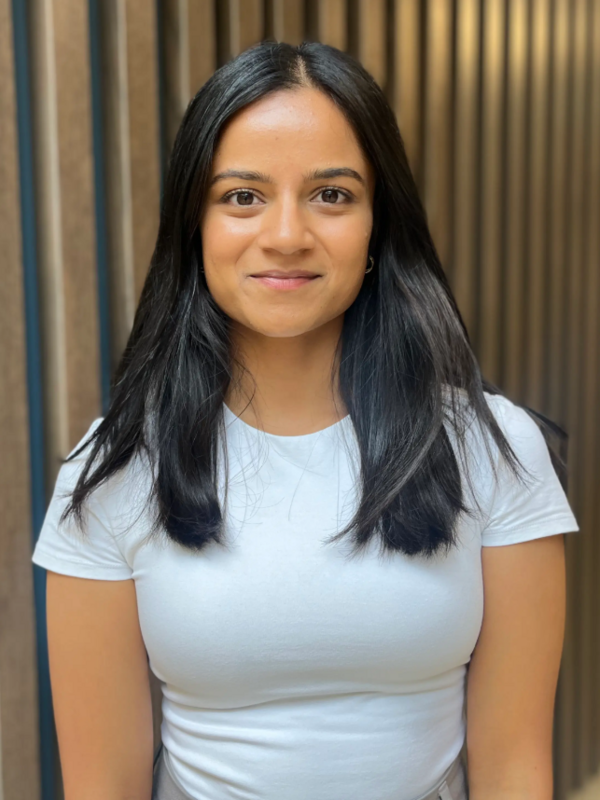Breadcrumbs
Leong practicum students reflect on their work in child health research
Over the past year, we were pleased to support two Master of Public Health students from the Dalla Lana School of Public Health at the University of Toronto as part of their practicum placements with us. Working alongside Centre Senior Research Associates, Dr. Andi Camden and Dr. Susitha Wanigaratne, they contributed to projects focused on child health equity research. Below, Diane Balkaran and Reshma Patel share highlights from their practicum experiences and the research they supported at the Centre.

Understanding the health of international students in Canada: A scoping review of peer-reviewed and grey literature
During my practicum at the Edwin S. H. Leong Centre for Healthy Children, I had the opportunity to contribute to a scoping review focused on the health of international students across Canada. Supervised by Dr. Susitha Wanigaratne and supported by research coordinator Ally Lucchese, our interdisciplinary team examined how international students access health care, what health outcomes they experience, and if there was a relationship between these outcomes and the social and structural determinants of health.
My role involved several key components of the review process. I conducted the title and abstract screening of 281 articles, followed by full-text screening of 52 articles. From these, I extracted data from 21 studies on their characteristics and findings. I also contributed to the manuscript by drafting sections of the introduction, methods, results, and discussion, and developed tables and figures to summarize and visualize our findings.
Beyond data collection and synthesis, I supported knowledge translation efforts by helping prepare and present our findings to community partners and academic collaborators. This collaborative dissemination was a valuable part of our project, enabling broader engagement with those who directly support international students in Canada.
This practicum enhanced my skills in evidence synthesis, stakeholder engagement, and collaborative writing. It also deepened my understanding of the unique challenges international students face in accessing healthcare in Canada. These experiences are directly transferable to my future career in public health, where I hope to contribute to research and policy initiatives that promote equitable access to care for marginalized populations.
Next steps for the project include finalizing the manuscript for submission to a peer-reviewed journal and continuing to share our findings with stakeholders through community-based knowledge exchange. I will also be contributing to the next phase of this project—a scoping review on the health of international students in the United States, the United Kingdom, Australia, Germany, France, Turkey, the Netherlands, and South Korea.
I’m grateful to the Edwin S.H. Leong Centre for Healthy Children for supporting this experience, which has strengthened my foundation in child health research and equipped me with knowledge and skills to take on future roles in research, policy, and program evaluation.

Building Canada’s first health data system for perinatal opioid exposure
For my Master of Public Health practicum, I contributed to a nationwide project addressing a critical public health issue: perinatal opioid exposure. Currently, Canada lacks a robust surveillance system to monitor opioid use during pregnancy and assess its impact on maternal and child health outcomes. Surveillance systems (or health data systems) are essential in public health as they generate data that drives action and prioritizes health interventions. Our project aims to develop the first pan-Canadian health data system for perinatal opioid use.
To guide the development of this system, we conducted a modified Delphi study to establish a set of consensus-driven indicators for monitoring perinatal opioid exposure and associated maternal-child health outcomes. We started with an environmental scan, identifying 61 potential indicators related to maternal health, social determinants, and child health. We then engaged 14 knowledge users including clinicians, researchers, and social workers from across Canada in two rounds of surveys followed by a final consensus meeting to refine and prioritize these indicators and identify any gaps.
One of the most critical phases of this project; qualitative interviews with participants with lived or living experiences (PWLLE) of opioids and pregnancy will take place in June. Insights from PWLLE will play a key role in shaping an indicator set that reflects real-world experiences and challenges and aligns with community-identified priorities.
Ultimately, the final consensus-driven indicators will feed into an open-access online dashboard, presenting administrative health data from across Canada. This health data system will provide population-level information about perinatal opioid use and its impact, identifying inequities and informing targeted, equity-focused responses in maternal and child health services. For more information and updates on the dashboard, visit www.CPOProject.ca.
I am incredibly grateful to the Edwin S.H. Leong Centre for Healthy Children and my supervisors for their guidance and mentorship. Working on this project has strengthened my understanding of how public health data systems can serve as impactful tools for advancing health equity. I have learned how meaningful collaboration and community engagement can fortify research to increase its efficacy for the communities it serves. This experience has reinforced my commitment to using data to drive equitable health outcomes and inform community-centered public health action. I am proud to have contributed to the Canadian Perinatal Opioid Project and to support efforts that strive for improved maternal-child health outcomes.
